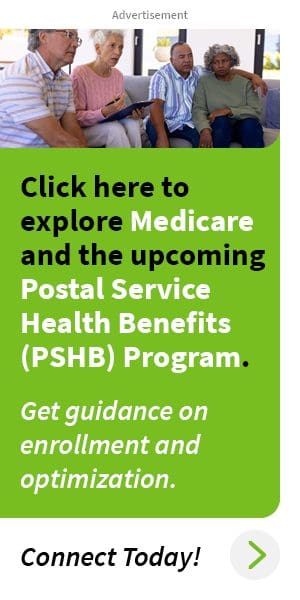Key Takeaways
-
The 2025 Postal Service Health Benefits (PSHB) changes require action during Open Season to ensure USPS employees and retirees maintain uninterrupted, optimized healthcare coverage.
-
Proactively reviewing plan options, Medicare integration, and coverage details now will prepare you for the upcoming transition.
The Importance of Preparing for PSHB Changes in 2025
The Postal Service Health Benefits (PSHB) program is set to redefine healthcare for USPS employees and retirees in 2025. This shift from the Federal Employees Health Benefits (FEHB) program introduces new coverage options, cost structures, and Medicare integration requirements designed to better serve postal workers. But with these changes come key deadlines and decisions that require your attention.
Whether you’re currently employed, retired, or a family member relying on USPS health benefits, now is the time to get prepared. Missing deadlines or failing to evaluate your options could lead to gaps in coverage or unexpected costs. Let’s explore what you need to do before the PSHB changes take effect.
Who Needs to Act Before 2025?
The PSHB program’s changes impact everyone connected to USPS healthcare. Here’s a breakdown:
-
Active Employees: You’ll need to select a PSHB plan during Open Season to ensure you’re covered in 2025. The tailored plans aim to address the unique needs of postal workers.
-
Retirees: If you’re Medicare-eligible, you must enroll in Medicare Part B to maintain PSHB coverage. This integration ensures comprehensive care and reduced out-of-pocket expenses.
-
Eligible Family Members: Spouses, children under 26, and certain disabled adult children remain eligible for PSHB coverage, provided they meet specific criteria.
What Makes PSHB Different from FEHB?
PSHB introduces several distinct features that make it a better fit for postal workers and retirees. Here’s how it’s different:
1. Medicare Integration
For retirees, Medicare enrollment becomes mandatory starting in 2025. Medicare Parts A and B will serve as the primary coverage, while PSHB plans fill the gaps by covering services like prescription drugs and specialist visits. This integration ensures seamless, comprehensive healthcare and significant cost savings.
2. Tailored Plans
Unlike FEHB, PSHB plans are designed specifically for USPS employees and retirees. They address the physical demands of postal work, providing preventive care, specialist access, and coverage that aligns with your unique health risks and needs.
3. Cost-Effective Structures
The PSHB program includes clear out-of-pocket maximums, shared premium contributions, and transparent deductibles. These changes aim to provide greater predictability and affordability for participants.
4. Automatic Enrollment
If you don’t actively select a plan during Open Season, you’ll be automatically enrolled in a default PSHB plan. While this ensures continuous coverage, it’s always better to review your options and choose a plan tailored to your healthcare needs.
Key Deadlines to Prepare For
Mark these important dates on your calendar to stay ahead:
-
Open Season: Typically mid-November through early December. Any changes or selections made during this period will take effect on January 1, 2025.
-
Medicare Enrollment Deadline: Medicare-eligible retirees must enroll in Part B by January 2025 to maintain their PSHB coverage.
-
Automatic Enrollment: If you don’t choose a plan during Open Season, you’ll be enrolled in a default plan. However, this might not be the best fit for your needs.
How to Evaluate Your Healthcare Needs
Understanding your healthcare requirements is the first step in selecting the right PSHB plan. Here’s what to consider:
Current Coverage Review
Take stock of your existing health plan:
-
What’s working well? Are there any gaps in coverage?
-
How often do you visit the doctor or specialist?
-
Do you require frequent prescriptions or have any chronic conditions?
Future Healthcare Planning
Anticipate any upcoming needs for 2025:
-
Do you have planned surgeries or medical procedures?
-
Are there family changes, such as a child aging out of dependent coverage?
-
Will you or your spouse become Medicare-eligible?
Steps to Take During Open Season
Open Season is your opportunity to make informed decisions about your healthcare coverage. Here’s how to approach it:
1. Compare Plan Options
Review all available PSHB plans. Pay attention to:
-
Deductibles and out-of-pocket maximums.
-
Coverage for your preferred providers and healthcare facilities.
-
Prescription drug benefits.
2. Check Medicare Integration
If you’re Medicare-eligible, ensure the PSHB plan you choose integrates smoothly with Medicare Parts A and B. This partnership reduces out-of-pocket expenses and offers comprehensive coverage.
3. Assess Provider Networks
Verify that your current doctors, specialists, and healthcare facilities are included in your chosen plan’s network to avoid surprises.
4. Consider Family Needs
If you’re covering dependents, ensure the plan provides adequate benefits for their healthcare requirements.
The Role of Medicare in PSHB Plans
For retirees, Medicare plays a central role in the new PSHB program. Here’s what you need to know:
Coordinated Coverage
Medicare Parts A and B will cover hospital and outpatient services, while PSHB fills in gaps like prescription drugs, specialist visits, and preventive care. This coordination ensures comprehensive coverage for your healthcare needs.
Lower Costs
By combining Medicare with PSHB, retirees can minimize out-of-pocket expenses. PSHB reduces the financial burden of coinsurance, copayments, and deductibles not fully covered by Medicare.
Avoiding Penalties
To maintain PSHB coverage, Medicare-eligible retirees must enroll in Part B by January 2025. Missing this deadline could result in penalties and gaps in coverage, so don’t delay.
Avoiding Common Mistakes
To ensure a smooth transition to PSHB, watch out for these pitfalls:
-
Procrastination: Missing Open Season or Medicare enrollment deadlines can lead to coverage gaps or higher costs.
-
Assuming Automatic Enrollment Is Enough: While it guarantees coverage, automatic enrollment might not offer the best plan for your needs. Review your options carefully.
-
Overlooking Details: Understand premium costs, deductibles, and out-of-pocket caps to avoid unexpected financial strain.
How to Stay Ahead of the Changes
With preparation, the PSHB transition can be a positive step toward better healthcare coverage. Here’s what you can do:
Stay Informed
Keep an eye on USPS communications about the PSHB program. Regular updates will provide details about plan options, deadlines, and requirements.
Plan for the Future
Evaluate your healthcare needs for 2025 and beyond. Whether it’s routine care, specialist visits, or managing a chronic condition, knowing what you’ll need helps you choose the right plan.
Act Early
Don’t wait until the last minute to explore your options. Use the time during Open Season to compare plans, ask questions, and finalize your choices.
What This Means for USPS Workers
The 2025 PSHB program is designed to offer tailored healthcare coverage and cost-saving opportunities, but it requires proactive planning. By understanding the changes, evaluating your needs, and acting during Open Season, you can ensure seamless healthcare coverage for yourself and your family.










